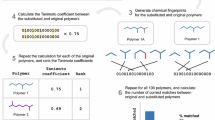Abstract
Topological properties of chemical library networks, such as the average clustering coefficient, average path length, and existence of hubs, can serve as indicators to describe the inherent complexities of chemical libraries. We have used Diversity-Oriented Synthesis (DOS) and Focussed Libraries to investigate the appearance of scale-free properties and absence of small-world behavior in chemical libraries. DOS aims to elicit structural complexity in small compounds with respect to skeleton, functional groups, appendages and stereochemistry. Complexity here indicates incorporation of \(\hbox {sp}^{3}\) carbons, hydrogen bond acceptors and donors in the molecule. Biological studies have shown how structural complexity enhances the interaction of molecules with complex biological macromolecules. In contrast, Focussed Libraries concentrate on specific scaffolds against a specific biological target. We have quantified the diversity in several DOS and Focussed Libraries based on properties of similarity and dissimilarity threshold networks formed from them. Similarity and dissimilarity networks were generated from diverse chemical libraries at various Tanimoto similarity coefficients (\(\hbox {t}_{\mathrm{c}})\) using FP2 and MACCS fingerprints. The dissimilarity networks at very low \(\hbox {t}_{\mathrm{c}}\) threshold led to the absence of small-world behaviors, as evidenced by low average clustering coefficient and high average path length in comparison to Erdös–Renyi networks. Dissimilarity networks exhibit scale free topology as evidenced by a power law degree distribution. The similarity networks at high \(\hbox {t}_{\mathrm{c}}\) threshold have shown high clustering coefficients and low average path lengths, without the appearance of hubs. Combining dissimilarity and similarity threshold graphs revealed assortative and dissortative behaviors in the DOS libraries, leading to the conclusion that the vertices of the dissimilarity communities are more likely to share similarity edges, but it is quite unlikely for the vertices in a similarity community to share dissimilarity edges. We propose a simple and convenient diversity quantification tool, QuaLDI (Quantitative Library Diversity Index) to quantify the diversity in DOS and Focussed libraries. We anticipate that these topological properties can be used as descriptors to quantify the diversity in chemical libraries before proceeding for synthesis.






Similar content being viewed by others
References
O. Raevsky, Mini-Rev. Med. Chem. 4, 1041 (2004)
M.E.J. Newman, Phys. Rev. E 69, 066133 (2004)
J. Hert, P. Willett, D.J. Wilton, J. Chem. Inf. Comput. Sci. 44, 1177 (2004)
BioSolveIT, SciTegic (2007) Pipeline Pilot. (Accelrys Software, San Diego, CA) . Version 6.1.5
N.M. O’Boyle, M. Banck, C.A. James, C. Morley, T. Vandermeersch, G.R. Hutchison, J. Cheminf. 3, 33 (2011)
RStudio Team, RStudio: Integrated Development for R (RStudio, Inc., Boston, MA, 2015), http://www.rstudion.com/
D. Rogers, M. Hahn, J. Chem. Inf. Model. 50, 742 (2010)
M.P. Krein, N. Sukumar, J. Phys. Chem. A 115, 12905 (2011)
N. Sukumar, S. Das, M. Krein, R. Godawat, I. Vitol, S. Garde, K.P. Bennett, C.M. Breneman, Computational approaches, in Cheminformatics and Bioinformatics, ed. by R. Guha, A. Bender (Wiley, Hoboken, 2011), pp. 107–143
R.W. Benz, S.J. Swamidass, P. Baldi, J. Chem. Inf. Model. 48, 1138 (2008)
T.G. Lewis, Network Science: Theory and Applications (Wiley, Hoboken, 2009)
D.J. Watts, S.H. Strogatz, Nature 393, 440 (1998)
A.L. Barabasi, R. Albert, Science 286, 509 (1999)
C. Qian, C. Hyunseok, R. Govindan, S. Jamin, IEEE Infocom. 2, 608 (2002)
H. Jeong, S.P. Mason, A.L. Barabasi, Z.N. Oltvai, Nature 411, 41 (2001)
G.F. Davis, M. Yoo, W.E. Baker, Strateg. Organ. 1, 301 (2003)
J.I. Perotti, F.A. Tamarit, S.A. Cannas, Phys. A 371, 71 (2006)
T. Kodadek, Curr. Opin. Chem. Biol. 14, 713 (2010)
J.Y. Ortholand, A. Ganesan, Curr. Opin. Chem. Biol. 8, 271 (2004)
P. Willett, Inform. Res. 2, 3 (1996)
D.K. Agrafiotis, V.S. Lobanov, J. Chem. Inf. Model. 39, 51 (1999)
E.A. Wintner, C.C. Moallemi, J. Med. Chem. 43, 1993 (2000)
H.M. Patel, M.N. Noolvi, P. Sharma, V. Jaiswal, S. Bansal, S. Lohan, S.S. Kumar, V. Abbot, S. Dhiman, V. Bhardwaj, Med. Chem. Res. 23, 4991–5007 (2014)
S.L. Schreiber, Science 287, 1964 (2000)
A. Grossmann, S. Bartlett, M. Janecek, J.T. Hodgkinson, D.R. Spring, Angew. Chem. 53, 13093 (2014)
B. M. Ibbeson, L. Laraia, E. Alza, C.J. O’Connor, Y. S. Tan, H.M.L. Davies, G. McKenzie, A. R. Venkitaraman, D.R. Spring, Nature Comm. 5, 3155 (2014)
V.S. Damerla, C. Tulluri, R. Gundla, L. Naviri, U. Adepally, P.S. Iyer, Y.L. Murthy, N. Prabhakar, S. Sen, Chem. Asian J. 7, 2351 (2012)
R. Mamidala, V.S. Babu Damerla, R. Gundla, M.T. Chary, Y.L.N. Murthy, S. Sen, RSC Adv. 4, 10619 (2014)
M. Cruz-Monteagudo, F. Borges, M. Perez Gonzalez, M.N. Cordeiro, Bioorg. Med. Chem. 15, 5322 (2007)
J.L. Durant, B.A. Leland, D.R. Henry, J.G. Nourse, J. Chem. Inf. Comput. Sci. 42, 1273 (2002)
G. Csardi, T. Nepusz, InterJournal Complex Syst. 1695 (2006). http://igraph.org
M. Zwierzyna, M. Vogt, G.M. Maggiora, J. Bajorath, J. Comput.-Aided Molec. Des. 29, 113 (2015)
R.D. Luce, A.D. Perry, Psychometrika 14, 95 (1949)
P. Erdös, A. Renyi, Pub. Math. 6, 290 (1959)
M.E.J. Newman, Phys. Rev. E 67, 02616 (2003)
M.E.J. Newman, Phys. Rev. Lett. 89, 208701 (2002)
A. Clauset, M.E.J. Newman, C. Moore, Phys. Rev. E 70, 066111 (2004)
M. Girvan, M.E. Newman, Proc. Natl. Acad. Sci. USA 99, 7821 (2002)
M.E.J. Newman, Phys. Rev. E 74, 036104 (2006)
P. Pons, M. Latapy, J. Graph Algorithms Applic. 10, 191 (2006)
M.E.J. Newman, Contemp. Phys. 46, 323 (2005). https://arxiv.org/abs/cond-mat/0412004
A. Clauset, C.R. Shalizi, M.E.J. Newman, SIAM Rev. 51(4), 661 (2009)
D.L. Evans, J.H. Drew, L.M. Leemis, Comm. Stat. - Simul. Comput. 37, 1396 (2008)
K. Wu, N. Sukumar, N. Lanzillo, C. Wang, R. Ramprasad, R. Ma, A.F. Baldwin, G. Sotzing, C.M. Breneman, J. Polymer Sci. B: Polymer Phys. (2016, in press)
Author information
Authors and Affiliations
Corresponding author
Rights and permissions
About this article
Cite this article
Prabhu, G., Bhattacharya, S., Krein, M.P. et al. Investigation of similarity and diversity threshold networks generated from diversity-oriented and focused chemical libraries. J Math Chem 54, 1916–1941 (2016). https://doi.org/10.1007/s10910-016-0657-0
Received:
Accepted:
Published:
Issue Date:
DOI: https://doi.org/10.1007/s10910-016-0657-0




